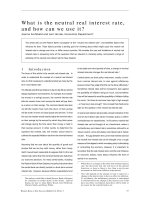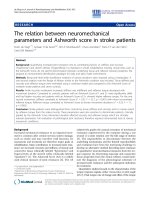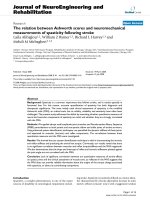- Trang chủ >>
- Khoa Học Tự Nhiên >>
- Vật lý
in prostate tests psa what is the difference between total psa and free psa
Bạn đang xem bản rút gọn của tài liệu. Xem và tải ngay bản đầy đủ của tài liệu tại đây (104.87 KB, 4 trang )
In prostate tests PSA what is the difference between total PSA and free PSA?
What is the normal range? In addition, how can it be that if there is ANY prostate
specific antigen in the blood that there is no prostate cancer?
Doesn’t the existence of any PSA means that the body is reacting with antibodies
against cancerous cells in the prostate.
PSA starts out in the fluid that carries sperm. PSA is a protein normally made in
the prostate gland in ductal cells. These cells make some of the semen that comes
out of the penis during sexual climax (orgasm). PSA helps to keep the semen
liquid.
PSA is measured by nanograms per millimeter of blood. Most men have under 4
nanograms. Anything higher can indicate prostate cancer. PSA traveling alone is
called free PSA. The free-PSA test measures the percentage of unbound PSA.
Rather than subject everyone with an elevated PSA to a biopsy, some urologists
measure free PSA in patients with a total PSA level between 4 ng/ml and 10 ng/ml.
A PSA level of 4 to 10 ng/ml is considered slightly elevated levels between 10 and
20 ng/ml are considered moderately elevated; and anything above that is
considered highly elevated. The presence of PSA does not necessarily mean that
the body is reacting against cancer cells Other conditions can affect PSA:
* Prostatitis and Lower Urinary Tract symptoms (LUTS) can elevate PSA
* BPH (benign hypertrophy or enlargment of the prostate) can elevate PSA
* Prostate cancer (PCa) often elevates PSA but not always. Some of the most
aggressive types of prostate cancer do NOT make or "leak" high levels of PSA.
Prostatitis and BPH are much commoner than prostate cancer.
Source(s): /> /> />PSA is a protein produced by the cells of the prostate gland. The most frequently
used PSA - prostate-specific antigen test - is the total PSA, which measures the
sum of the free PSA and the cPSA (complex or bound) in the blood. When a doctor
orders a “PSA test,” he is referring to a total PSA. When the prostate gland
enlarges, PSA levels in the blood tend to rise. PSA levels can rise due to cancer or
benign (non cancerous) conditions. Because PSA is produced by the body and can
be used to detect disease, it is sometimes called a biological marker or tumour
marker. The PSA level that is considered normal for an average man ranges from 0
to 4 nanograms per milliliter (ng/ml). A PSA level of 4 to 10 ng/ml is considered
slightly elevated; levels between 10 and 20 ng/ml are considered moderately
elevated; and anything above that is considered highly elevated. The higher a man's
PSA level, the more likely it is that cancer is present. But because various factors
can cause PSA levels to fluctuate, one abnormal PSA test does not necessarily
indicate a need for other diagnostic tests. When PSA levels continue to rise over
time, other tests may be indicated. A man should discuss elevated PSA test results
with his doctor. There are many possible reasons for an elevated PSA level,
including prostate cancer, benign prostate enlargement, inflammation, infection,
age, and race. If there are no other indicators that suggest cancer, the doctor may
recommend repeating DRE (digital rectal examination) and PSA tests regularly to
monitor any changes. Using the PSA test to screen men for prostate cancer is
controversial because it is not yet known if the process actually saves lives.
Moreover, it is not clear if the benefits of PSA screening outweigh the risks of
followup diagnostic tests and cancer treatments. The procedures used to diagnose
prostate cancer may cause significant side effects, including bleeding and
infection. Prostate cancer treatment often causes incontinence and impotence. For
these reasons, it is important that the benefits and risks of diagnostic procedures
and treatment be taken into account when considering whether to undertake
prostate cancer screening. PSA circulates in the blood in two forms - free or
attached to a protein molecule. With benign prostate conditions, there is more free
PSA, while cancer produces more of the attached form. Researchers are exploring
different ways to measure PSA and to compare these measurements to determine if
cancer is present.
ALL ANSWERS SHOULD BE THOROUGHLY RESEARCHED, IN ANY FORUM AND
ESPECIALLY IN THIS ONE. - MANY ANSWERS ARE FLAWED.
It is extremely important to obtain an accurate diagnosis before trying to find a
cure. Many diseases and conditions share common symptoms.
The information provided here should not be used during any medical emergency
or for the diagnosis or treatment of any medical condition. A licensed physician
should be consulted for diagnosis and treatment of any and all medical conditions.
I add a link with details of this subject
understanding/analytes/psa/test.html
Intermethod Differences in Results for Total PSA, Free PSA, and Percentage
of Free PSA
Patricia R. Slev, PhD; Sonia L. La'ulu; William L. Roberts, MD, PhD
Authors and Disclosures
Posted: 06/25/2008; American Journal of Clinical Pathology. 2008;129(6):952-958. © 2008
American Society for Clinical Pathology
Abstract
Serum prostate-specific antigen (PSA) assays differ in calibration and response to different PSA
forms. We examined intermethod differences in total PSA (tPSA) and free PSA (fPSA)
measurements. We tested 157 samples with tPSA concentrations of 2 to 10 ng/ mL (2-10 µg/L)
using 6 PSA/fPSA method pairs and 1 tPSA method: ADVIA Centaur (complexed and total;
Siemens Diagnostics, Tarrytown, NY), ARCHITECT i2000
SR
(Abbott Diagnostics, Abbott Park,
IL), AxSYM (Abbott Diagnostics), IMMULITE 2000 (Siemens Diagnostics), Modular E170
(Roche Diagnostics, Indianapolis, IN), UniCel DxI 800 (Beckman Coulter, Brea, CA), and
VITROS ECi (tPSA only; Ortho- Clinical Diagnostics, Raritan, NJ). Regression analysis was
performed for PSA, fPSA, and percentage of fPSA with the ARCHITECT i2000
SR
comparison
method. Differences between test and comparison methods were estimated at 2.5, 4.0, and 10.0
ng/mL (2.5, 4.0, and 10.0 µg/L) for tPSA and 15%, 20%, and 25% for percentage of fPSA.
Relative differences were more than 10% at 4.0 ng/mL (4.0 µg/L) tPSA for the Centaur,
IMMULITE, ECi, and DxI methods. At 20% fPSA, the relative difference was more than 10% for
all methods except the AxSYM. Additional harmonization is needed for tPSA and fPSA methods.
Introduction
Prostate cancer is the second leading cause of cancer-related deaths for men in the United States.
[1]
It has been suggested that screening for prostate cancer may have reduced prostate cancer
mortality rates, but this remains controversial.
[2]
Current American Cancer Society guidelines for
prostate cancer screening recommend a digital rectal examination and prostate-specific antigen
(PSA) measurement annually for all men 50 or older if they have a minimum life expectancy of
10 years.
[3]
Although PSA is cleared by the Food and Drug Administration for monitoring
patients with prostate cancer for disease recurrence, it is unique in that it is the only tumor
marker that is currently approved by the Food and Drug Administration as an aid in the detection
of prostate cancer. PSA testing for prostate cancer detection, however, is complicated for many
reasons. First, PSA exists in multiple isoforms. Although there are many complexed forms that
circulate in low concentrations in blood, the 2 principal forms that are measured by current
methods are PSA complexed with α
1
-antichymotrypsin (complexed PSA) and uncomplexed, or
free, PSA (fPSA). Many automated analyzers have assays to measure total PSA (tPSA), and
most can measure at least 1 of the 2 principal forms directly.
Second, screening with PSA is problematic because PSA is really an organ-specific marker for
the prostate rather than a specific marker for cancer. Controversy exists regarding the medical
decision levels for tPSA and percentage of fPSA within the United States and abroad.
[4]
For tPSA
concentrations, a diagnostic gray zone exists for patients with PSA concentrations between 4.0
and 10.0 ng/mL (4.0-10.0 µg/L). Many patients with PSA concentrations greater than 10.0
ng/mL (10.0 µg/L) have advanced disease, but within this gray zone only 25% have cancer, and
controversy exists whether these are the patients who have early-stage disease and would benefit
from detection or whether these are the patients who have indolent forms of prostate cancer.
Therefore, recommendations indicate that a biopsy should be performed in any patient with a
tPSA result that is greater than 10.0 ng/mL (10.0 µg/L), and further investigation is warranted in
patients who are in the diagnostic gray zone and have a result between 4.0 and 10.0 ng/mL (4.0-
10.0 µg/L) tPSA.
[5-9]
In high-risk populations, a biopsy is recommended if the tPSA is 2.5 ng/mL
(2.5 µg/L) or more.
[3]
It has been recently suggested that this lower tPSA cutoff should be
adopted for screening men of all ages.
[10]
Although the medical decision points for percentage of
fPSA are also equally controversial, it is generally accepted that measuring fPSA and calculating
the percentage of fPSA aids in distinguishing cancer from other benign prostate conditions such
as benign prostate hyperplasia, particularly for the population in the diagnostic gray zone.
[3,11,12]
The lower the fPSA/tPSA ratio, the greater the likelihood of cancer.
[11]
Currently, biopsy is
recommended for 15%, 20%, or 25% fPSA.
[11,13,14]
Third, PSA measurements are further complicated by the fact that different assays measure
different PSA isoforms to varying extents. Although a certain amount of variation is inevitable
because different methods have antibodies that recognize different epitopes of PSA, ideally,
assays that measure tPSA should be equimolar and unbiased in the detection of free and
complexed PSA. Historically, however, different assays have produced significantly different
results for PSA on the same sample. Although lack of an equimolar response was in part
responsible for this phenomenon, the other problem was the lack of calibration against a
universal standard. In an effort to standardize PSA methods, the World Health Organization
(WHO) developed a standard, the WHO (90:10) (National Institute for Biological Standards and
Control 96/670) PSA reference preparation, that consists of 90% PSA complexed to α
1
-
antichymotrypsin and 10% fPSA.
[15]
Recent studies evaluated automated methods using this
standard, and although bias between different methods has been significantly reduced, results
between assays are not interchangeable for tPSA or fPSA,
[16-19]
which complicates absolute PSA
value recommendations for tPSA cutoffs and interpretation of the fPSA/tPSA ratio.
The aim of our study was to compare 6 commercially available automated methods for PSA
concentrations (total and free) by using real patient samples that would minimize matrix effects
to determine the degree of method-dependent bias in patient results at critical cutoffs. Our study
is unique not only because we evaluated differences using Passing-Bablok analysis but also
because statistical differences between methods and concordance at critical cutoffs were
determined.









